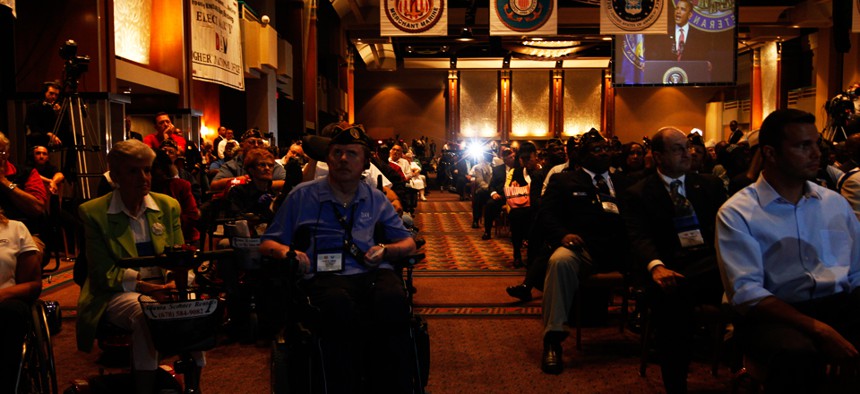
Audience members listen as President Barack Obama speaks about Iraq and Afghanistan at the Disabled American Veterans national convention in Atlanta in 2010. Charles Dharapak/AP file photo
A Special Sick Leave Bank for Disabled Vets?
Proposal would help new feds who are disabled veterans attend mandatory medical appointments without burning up sick leave.
Veterans and the management of the Veterans Affairs Department have been front and center these last few weeks because of the controversy over reports of secret waiting lists for medical appointments, and the recent deaths of vets who were waiting for care. The spotlight on the quality of veterans’ care might be new, but problems with access to that care are not.
Of the many ideas and bills circulating in Washington now related to veterans, at least one seems relatively straightforward and potentially bipartisan. The Federal Managers Association is pushing Congress and the Obama administration to come up with a legislative or executive fix to help new federal employees who also are disabled veterans attend their mandatory medical appointments without dipping into their sick leave, or having to take leave without pay to get care.
Full-time federal workers in their first year on the job have a zero sick leave balance when they start, accruing four hours of such leave per pay period. That amounts to a balance of 104 hours at the end of their first year. But disabled vets, who must attend regular medical appointments to take care of their health, but also to continue receiving their veterans’ benefits, quickly burn up their sick leave, according to FMA. So the organization wants to work with Congress and the Office of Personnel Management on coming up with a solution: creating a sick-leave bank specifically for disabled vets who are first-year federal employees to be used for medical treatment related to their service-connected disability.
“While federal employees can be advanced leave and banks are available, it often does not cover what is needed to meet these medical requirements for chronic disabilities and they are forced to take leave without pay,” FMA said in an issue brief on its 2014 legislative recommendations.
Many vets also have to travel far to reach the nearest VA facility to receive treatment, which eats up leave time, FMA pointed out.
Twenty-one percent of disabled vets applied for disability compensation benefits; of that number, 73 percent received a disability rating from VA, according to VA’s 2012 National Survey of Veterans.
Benefits for Military Families
The House on May 22 passed its fiscal 2015 Defense authorization bill with a number of provisions aimed at helping military families. One amendment expands maternity leave for active-duty service members by giving them an additional six weeks of unpaid leave, for a total of 12 weeks, in keeping with the 1993 Family and Medical Leave Act. The amendment was originally a stand-alone bill sponsored by Rep. Tammy Duckworth, D-Ill. The amendment allows commanders to call service members back to active duty “at any given time to maintain unit readiness.”
Other amendments incorporated into the bill would:
- Make available breastfeeding support, supplies and counseling under the TRICARE program.
- Direct the Defense secretary to do a report evaluating the progress of the Military Spouse Employment Program in reducing military spouse unemployment, reducing the pay gap between military spouses and their civilian counterparts and addressing the underemployment of military spouses.
- Ensure access to behavioral health treatment, including applied behavior analysis, under TRICARE for children with developmental disabilities, when prescribed by a physician or psychologist.
TSP Survey
Thrift Savings Plan enrollees are satisfied with their retirement portfolio and “its competitiveness compared to similar private-sector plans,” according to a survey conducted by Aon Hewitt for the Federal Retirement Thrift Investment Board. Eighty-seven percent of respondents were satisfied -- an increase of 1 percentage point over 2011 levels, the biannual survey found. Ninety-five percent rated the TSP as competitive or better compared to other employers’ savings plans and 58 percent said it is “above or well above others,” the survey reported.
The response rate, however, was only 12 percent. Consulting firm Aon Hewitt conducted the survey between September and November 2013 through a paper mailing (with the option to complete it online) to a random sample of 46,733 active TSP participants, including retirees and military service members. Of that number, just 5,524 responded, which was below the 2011 response rate of 15 percent.
NEXT STORY: Retirement Readiness: How Do You Stack Up?







